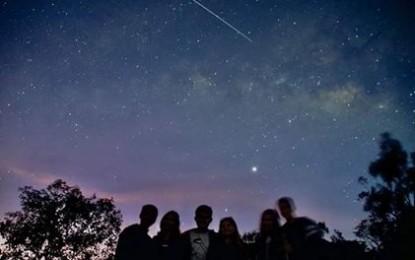
WISH UPON A FALLING STAR. A photo of the Philippine Astronomical Society Inc. on its Facebook page shows some members during a Lyrid meteor shower watching last year. But the annual watch was canceled this year due to the enhanced community quarantine brought about by the coronavirus (Covid-19) pandemic. (Photo from the PAS Facebook Page)
BAGUIO CITY – Early morning rains spoiled what could be a great firework display right before dawn Thursday.
The Lyrids meteor showers were deterred to make a show before dawn as slight rains started pouring here around 2 a.m. when the spectacle was about to start.
Some 10-20 meteors including fireballs were expected to illuminate the skies apparently emanating from the northeastern portion were the Lyra Constellation or the harp. The constellation can be easily found as it is highlighted by its main star, Vela, one of the sky’s brightest.
The Philippine Astronomical Society (PAS) on its Facebook page said that around 10 meteors per hour were supposed to lit the skies during the Lyrids peak and last show today.
On Wednesday morning, some 15 Lyrid meteors were observed by members of the group at their respective residences in one of the major meteor showers annually. The PAS said that these “meteors are associated with Comet Thatcher’s debris, which burns as it enters our atmosphere.”
It said that the pre-dawn hours were the best time to see the annual spectacle which the PAS organizes in April but was skipped this year due to the coronavirus (Covid-19) pandemic.
Facebook user and PAS member Biloy Baluso said that he was able to see the spectacle in his hometown in General Santos City around 4:40 a.m. of April 22 between the Aquarius and Aquila constellations.
Baluso enjoyed clear skies in the southern city, much to the annoyance of Baguio people hoping to catch a glimpse of the spectacle especially during the enhanced community quarantine where all are required to stay home especially at night.
Moderate rains came falling at around 2 a.m. that lasted until 2:40 a.m., tapered off at about 3 a.m. but then a steady drizzle ensued after.
Baguio has been under heavy clouds the past two weeks with some rains on occasions.
A clear sky could give the best view of the skies as the moon was at its darkest phase.
Facebook user Roger Desiderio said that he saw one near the star Altair, alpha of the constellation Aquila, another bright evening sparkler.
Some night watchmen took advantage also of the alignment of the three nearest planets to Earth, Mars, Jupiter, and Saturn, which are still on full display at this time of the year.
Veteran photographer Noli Gabilo was disappointed anew after he failed to shoot on April 22 at a friend’s place at QM Subdivision.
The Batanes-born photographer, who calls Baguio as a second home, had already set up his tripod at the house’s terrace that serves as his observatory for his regular shoots only to be deterred by the rains.
“Ayon basang basa na ang tripod sa labas (There, the tripod is now soaked outside),” he said.
“There was a window yesterday, but then the fog came in,” he said referring to his watch last April 22. (PNA)
